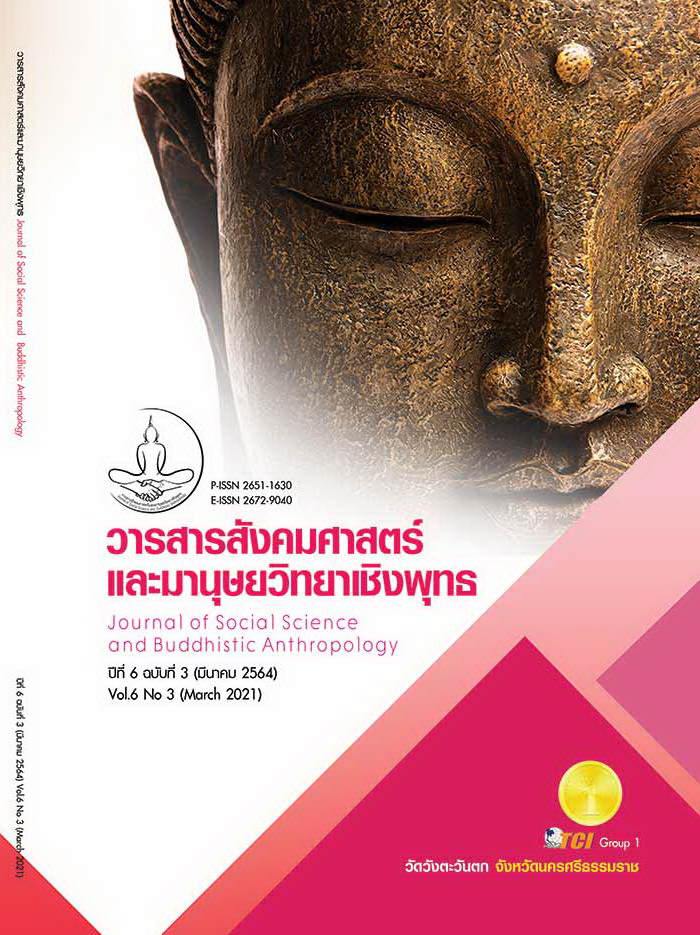HUMAN RESOURCE DIVERSITY MANAGEMENT IN ORGANIZATION FOR EQUALITY AND FAIRNESS: A CASE STUDY ON HUMAN CAPITAL DEVELOPMENT OF EMPLOYEES WITH DISABILITIES IN GOVERNMENT SECTOR
Keywords:
Diversity Management, Persons with Disabilities, Human Capital Development, Career PathAbstract
The objectives of this research article were 1) to study the human capital development process of government agencies organized for employees with disabilities for equality and fairness and 2) to study the limitations of employees with disabilities to attend the human capital development process within government organizations. This research article used the qualitative research model including document analysis, in-depth interviews, and focus group interviews. The samples consisted of 58 persons who were supervisors, colleagues, and employees with disabilities in 4 ministries. The samples were selected by using the stratified sampling method, the purposive sampling method, and the snowball or chain sampling method. The tools used to collect data were in-depth interviews. Data were analyzed from document analysis, information from in-depth interviews and focus groups. The research results were found as follows: 1) The human capital development processes managed by government agencies for employees with disabilities for equality and fairness were 1.1) the main priority of the human capital development was preparing people with disabilities to enter the organization and providing living skills with others in the organization, 1.2) employees with disabilities had the opportunity to develop, train and grow in a career path equally and fairly, and 1.3) the most common method of human capital development for employees with disabilities was teaching while working or on-the-job training . 2) Limitations resulting in inequality and fairness to the human capital development of employees with disabilities were 2.1) disability was raised as a limitation on the development of employees with disabilities, 2.2) the types of positions of employees with disabilities affected the opportunity for training, and 2.3) some types of employees with disabilities were not able to enter the career path process because of some complications and a lot of information involved.
References
กรนัย (นามสมมุติ). (22 พฤศจิกายน 2562). การจัดการความหลากหลายในมิติการพัฒนาทุนมนุษย์พนักงานผู้พิการในองค์การภาครัฐเพื่อความเสมอภาคและเป็นธรรม. (สุชาวดี เดชทองจันทร์, ผู้สัมภาษณ์)
กรมส่งเสริมและพัฒนาคุณภาพชีวิตคนพิการ. (2562). สถานการณ์คนพิการ 31 ธันวาคม 2562. เรียกใช้เมื่อ 11 มกราคม 2563 จาก http://www.dep.go.th/uploads/Docutents/8565960f-cb64-416a-827f-643a8a34ee15รายละเอียดข้อมูลคนพิการ%20ธ.ค.62.pdf
เก้า (นามสมมุติ). (4 ตุลาคม 2562). การจัดการความหลากหลายในมิติการพัฒนาทุนมนุษย์พนักงานผู้พิการในองค์การภาครัฐเพื่อความเสมอภาคและเป็นธรรม. (สุชาวดี เดชทองจันทร์, ผู้สัมภาษณ์)
คนล่าฝันรางวัลแห่งชีวิต (นามสมมุติ). (22 ตุลาคม 2562). การจัดการความหลากหลายในมิติการพัฒนาทุนมนุษย์พนักงานผู้พิการในองค์การภาครัฐเพื่อความเสมอภาคและเป็นธรรม. (สุชาวดี เดชทองจันทร์, ผู้สัมภาษณ์)
จินนี่ (นามสมมุติ). (6 พฤศจิกายน 2562). การจัดการความหลากหลายในมิติการพัฒนาทุนมนุษย์พนักงานผู้พิการในองค์การภาครัฐเพื่อความเสมอภาคและเป็นธรรม. (สุชาวดี เดชทองจันทร์, ผู้สัมภาษณ์)
ไจแอนต์ (นามสมมุติ). (22 ตุลาคม 2562). การจัดการความหลากหลายในมิติการพัฒนาทุนมนุษย์พนักงานผู้พิการในองค์การภาครัฐเพื่อความเสมอภาคและเป็นธรรม. (สุชาวดี เดชทองจันทร์, ผู้สัมภาษณ์)
ดวงตา (นามสมมุติ). (31 สิงหาคม 2562). การจัดการความหลากหลายในมิติการพัฒนาทุนมนุษย์พนักงานผู้พิการในองค์การภาครัฐเพื่อความเสมอภาคและเป็นธรรม. (สุชาวดี เดชทองจันทร์, ผู้สัมภาษณ์)
เดชา เดชะวัฒนไพศาล. (2559). การจัดการทรัพยากรบุคคล พื้นฐานแนวคิดเพื่อการปฏิบัติ. กรุงเทพมหานคร: สำนักพิมพ์แห่งจุฬาลงกรณ์มหาวิทยาลัย.
ทวีศักดิ์ สูทกวาทิน. (2551). การจัดการทรัพยากรมนุษย์เชิงกลยุทธ์. กรุงเทพมหานคร: ทีพีเอ็น เพรส.
นันท์ (นามสมมุติ). (31 สิงหาคม 2562). การจัดการความหลากหลายในมิติการพัฒนาทุนมนุษย์พนักงานผู้พิการในองค์การภาครัฐเพื่อความเสมอภาคและเป็นธรรม. (สุชาวดี เดชทองจันทร์, ผู้สัมภาษณ์)
นิตยรัฐ (นามสมมุติ). (25 ตุลาคม 2562). การจัดการความหลากหลายในมิติการพัฒนาทุนมนุษย์พนักงานผู้พิการในองค์การภาครัฐเพื่อความเสมอภาคและเป็นธรรม. (สุชาวดี เดชทองจันทร์, ผู้สัมภาษณ์)
นิสดารก์ เวชยานนท์. (2554). การบริหารทุนมนุษย์เชิงกลยุทธ์เพื่อเพิ่มมูลค่า. กรุงเทพมหานคร: สถาบันบัณฑิตพัฒนบริหารศาสตร์.
พันศรี (นามสมมุติ). (19 พฤศจิกายน 2562). การจัดการความหลากหลายในมิติการพัฒนาทุนมนุษย์พนักงานผู้พิการในองค์การภาครัฐเพื่อความเสมอภาคและเป็นธรรม. (สุชาวดี เดชทองจันทร์, ผู้สัมภาษณ์)
ลักษนา (นามสมมุติ). (27 พฤศจิกายน 2562). การจัดการความหลากหลายในมิติการพัฒนาทุนมนุษย์พนักงานผู้พิการในองค์การภาครัฐเพื่อความเสมอภาคและเป็นธรรม. (สุชาวดี เดชทองจันทร์, ผู้สัมภาษณ์)
ศัก (นามสมมุติ). (20 สิงหาคม 2562). การจัดการความหลากหลายในมิติการพัฒนาทุนมนุษย์พนักงานผู้พิการในองค์การภาครัฐเพื่อความเสมอภาคและเป็นธรรม. (สุชาวดี เดชทองจันทร์, ผู้สัมภาษณ์)
ศิริยุพา รุ่งเริงสุข. (2558). D&I เทรนด์ HR ที่มาแรง. เรียกใช้เมื่อ 24 กันยายน 2562 จาก https://www.bangkokbiznews.com/blog/detail/635110
สุธินี ฤกษ์ขำ. (2560). การพัฒนาทรัพยากรมนุษย์ หลักการและการประยุกต์. กรุงเทพมหานคร: จุฬาลงกรณ์มหาวิทยาลัย.
โสพิศ หมัดป้องตัว. (2558). Workshop on diversity management and human capital strategy. เรียกใช้เมื่อ 24 กันยายน 2562 จาก https://www.ftpi.or.th/wp-content/uploads/2016/01/15RP12WSPDiversity-SopisM05Dec15.pdf
โอ้ (นามสมมุติ). (22 ตุลาคม 2562). การจัดการความหลากหลายในมิติการพัฒนาทุนมนุษย์ของพนักงานผู้พิการในองค์การภาครัฐเพื่อความเสมอภาคและเป็นธรรม. (สุชาวดี เดชทองจันทร์, ผู้สัมภาษณ์)
Ardakani, M. S. et al. (2015). Diversity management and human resources productivity: Mediating effects of perceived organizational attractiveness, organizational justice and social identity in Isfahan’s steel industry. Iranian Journal of Management Studies (IJMS), 9(Spring), 407-432.
Brimhall, K. C. et al. (2014). The mediating role of inclusion: A longitudinal study of the effects of leader–member exchange and diversity climate on job satisfaction and intention to leave among child welfare workers. Children and Youth Services Review, 40(2014), 79-88.
Cooke, F. L. & Saini, D. S. (2010). Diversity Management India: A Study of Organizations in Different Ownership Forms And Industrial Sectors. Human Resource Management, 49(3), 477-500.
Kaur, R. A., et al. (2014). Equity Sensitivity. The International Journal of Business & Management, 2(6), 230-233.
Noe, R. A., et al. (2012). Human Resource Management. USA: McGraw-Hill.
Rosado, C. (2006). What Do We Mean By “Managing Diversity? Retrieved September 24 , 2019, from http://www.edchange.org/multicultural/papers/rosado_managing_diversity.pdf
Yap, M. H. T. (2016). Diversity Management in Vietnam’s Hospitality Industry. Journal of Human Resources in Hospitality & Tourism, 15(2), 147-165.








